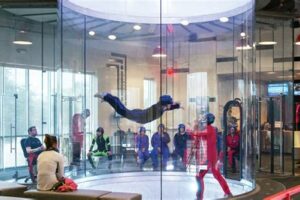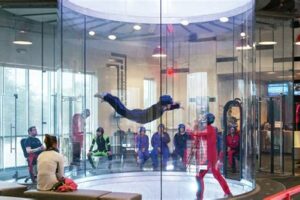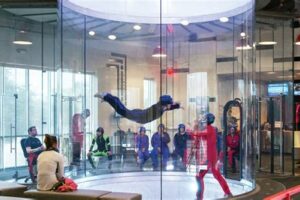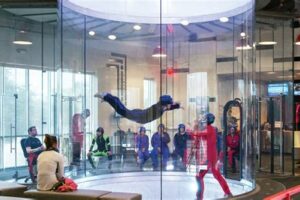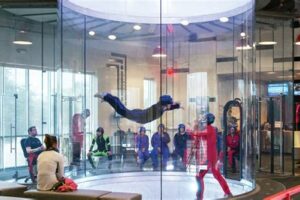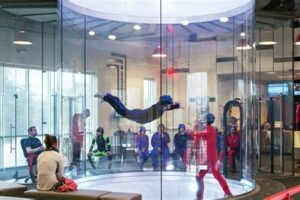Table of Contents
Wondering if you can indulge in indoor skydiving despite having back problems? Get expert advice on whether it’s safe for you to experience the thrill of indoor skydiving with a back condition. Understand the potential risks, precautions, and alternative activities that can provide a similar adrenaline rush without aggravating your back issues.
Are you an adventure enthusiast with a love for adrenaline-pumping activities like skydiving? If so, you might be wondering if indoor skydiving is a suitable alternative for those with back problems. Whether you are recovering from an injury or have a chronic condition, it’s essential to prioritize your safety while still enjoying thrilling experiences. In this article, we will explore the world of indoor skydiving and delve into whether it can be done by individuals with back problems. So, fasten your seatbelt and get ready to soar through the air – we’re about to uncover the truth behind indoor skydiving and its compatibility with back issues.
Introduction
Indoor skydiving has become a popular activity for adventure seekers and thrill enthusiasts. It allows individuals to experience the thrill of freefalling in a controlled environment. However, for those with back problems, the question arises, can you do indoor skydiving without risking further damage to your back? In this article, we will explore whether indoor skydiving is suitable for individuals with back problems and provide some tips for those considering this exhilarating activity.
Understanding Back Problems
Back problems can range from minor muscular strains to more severe conditions such as herniated discs or spinal stenosis. Each individual’s back problem is unique, and it is crucial to understand the specific limitations and risks associated with your condition before engaging in any physical activity, including indoor skydiving.
Consulting a Medical Professional
Prior to attempting indoor skydiving or any other physically demanding activity, it is essential to consult with a medical professional who specializes in back problems. They will be able to evaluate your condition, assess the risks, and provide guidance on whether indoor skydiving is suitable for you.
The Impact of Freefalling
One of the main concerns for individuals with back problems when it comes to indoor skydiving is the impact of freefalling. During indoor skydiving, you are suspended in a vertical wind tunnel, and the force of air keeps you afloat. While the sensation is similar to actual skydiving, the impact on your body is significantly reduced.
Reduced Impact on the Back
Indoor skydiving is often considered a low-impact activity, as it does not involve the jarring landings associated with traditional outdoor skydiving. The controlled environment of the wind tunnel ensures that the force exerted on your body is distributed evenly. This reduced impact can be beneficial for individuals with back problems who want to experience the thrill of skydiving without aggravating their condition.
The Importance of Proper Technique
While indoor skydiving may be suitable for individuals with back problems, it is crucial to maintain proper technique throughout the activity. This includes maintaining a neutral spine position, engaging your core muscles, and avoiding sudden or jerky movements that could strain your back. Adhering to these principles can help minimize the risk of exacerbating your back problems during indoor skydiving.
Gradual Progression
If you have recently experienced back problems or are unsure about the impact of indoor skydiving on your condition, it is advisable to start with shorter sessions and gradually increase the duration. This allows you to assess how your back responds to the activity and make adjustments accordingly. It is always better to err on the side of caution and prioritize your long-term back health.
Considerations for Specific Back Conditions
Depending on the nature and severity of your back problems, there may be additional considerations to take into account before attempting indoor skydiving. For individuals with herniated discs or spinal stenosis, the rapid changes in air pressure during freefalling may cause discomfort or exacerbate symptoms. It is crucial to discuss these specific concerns with your medical professional and follow their advice.
Alternative Activities
If indoor skydiving is not recommended for your back condition, there are numerous alternative activities that can still provide an adrenaline rush and a sense of adventure. These may include activities such as zip-lining, rock climbing (with proper safety precautions), or even virtual reality experiences that simulate the sensation of skydiving without physical strain on your back.
Final Thoughts
While indoor skydiving can be a thrilling experience, individuals with back problems should approach it with caution. Consulting a medical professional, understanding your specific back condition, and adhering to proper technique are essential steps to minimize the risk of further damage. If indoor skydiving is not recommended for your back condition, there are plenty of alternative activities available that can still provide an exhilarating experience. Ultimately, prioritizing your long-term back health should be the primary concern when considering any physically demanding activity.
Introduction:
Indoor skydiving has become a popular recreational activity for thrill-seekers around the world. However, individuals with back problems may wonder if they can participate safely in this high-flying adventure. In this article, we will explore whether indoor skydiving is a viable option for those with back issues, providing you with the necessary insights to make an informed decision.
1. Understanding the Impact on the Spine:
Indoor skydiving involves being propelled by a vertical wind tunnel, which generates a strong upward airflow to simulate a freefall experience. While this exhilarating activity generally doesn’t put strain directly on the back, it’s essential to consider the potential impact on the spine. Individuals with existing back problems should consult with their healthcare professional to understand the potential risks specific to their condition.
2. Evaluating Stability and Upper Body Strength:
Before venturing into indoor skydiving, it’s crucial to assess your stability and upper body strength, as they play a significant role in maintaining proper body positioning during the activity. Individuals with back problems should work closely with a fitness trainer or physical therapist to assess and improve any deficiencies that might impact their ability to stabilize their back during the wind tunnel experience.
3. Discussing the Activity with Healthcare Professionals:
To ensure your safety and minimize the risk of exacerbating existing back problems, it is advisable to consult with your healthcare professional prior to trying indoor skydiving. They can evaluate your condition and provide personalized recommendations or restrictions based on their expertise and understanding of your back issues. This conversation will help determine whether it is safe for you to participate in this exhilarating activity.
4. Considering the Nature of Your Back Problem:
The nature and severity of your back problem should be taken into account when contemplating indoor skydiving. Conditions such as herniated discs, spinal stenosis, or chronic back pain may require additional caution. Seeking the advice of a healthcare professional who is knowledgeable about these issues will help you make an informed decision regarding your suitability for indoor skydiving.
5. Exploring Modifications and Safety Equipment:
Indoor skydiving centers often have safety measures in place to accommodate individuals with physical limitations or disabilities. It’s important to discuss any modifications or necessary safety equipment with the facility beforehand. They may have special harnesses or padding options to provide additional support for individuals with back problems during their flight.
6. Being Cautious and Starting Slow:
Many indoor skydiving facilities offer introductory sessions, allowing participants to get a taste of the experience before committing to a longer flight. This can be beneficial for individuals with back problems, as it allows them to assess how their back responds to the activity and evaluate any discomfort or pain. Starting with shorter sessions and gradually increasing the duration can help minimize the risk of exacerbating back problems.
7. Monitoring Your Body’s Response:
During and after indoor skydiving, it is crucial to pay attention to your body’s response. If you experience any discomfort, pain, or increased back problems, it is advised to stop immediately and consult with your healthcare professional. They can provide guidance on whether you should continue participating, modify your approach, or opt for alternative activities that are safer for your back.
8. Exploring Non-Skydiving Alternatives:
If indoor skydiving is deemed unsuitable for your back problems, there are various alternative activities that can still provide a thrilling experience while reducing the stress on your back. Some examples include adrenaline-pumping zip-lining, rock climbing, or even virtual reality-based skydiving simulations. These activities can help satisfy your adventure cravings while minimizing the potential risks to your back.
Conclusion:
In conclusion, individuals with back problems should approach indoor skydiving with caution and consult with their healthcare professional before participating. While the activity generally doesn’t place direct strain on the back, the nature and severity of back problems differ among individuals. By considering the advice of healthcare professionals, evaluating your own physical condition, and monitoring your body’s response, you can make an informed decision about whether indoor skydiving is suitable for you. Remember, your safety and well-being should always be the top priority.
Indoor skydiving is an exhilarating experience that allows individuals to enjoy the sensation of freefalling in a controlled environment. However, for those with back problems, participating in this activity may raise concerns about potential discomfort or exacerbation of their condition. It is essential to consider the implications and consult with a healthcare professional before engaging in indoor skydiving with back problems.
Here are some key points to consider:
- Consultation with a healthcare professional: Before attempting indoor skydiving, individuals with back problems should schedule an appointment with their healthcare provider. A professional evaluation can help determine whether it is safe for them to participate in this activity. They will be able to assess the severity of the back problem, identify any contraindications, and provide specific recommendations.
- Understanding the physical demands: Indoor skydiving involves maintaining a stable body position while being suspended in a vertical wind tunnel. This requires core strength and stability, which may put strain on the back. Individuals with back problems should carefully consider whether their condition allows them to meet these physical demands without compromising their comfort or safety.
- Risk of aggravating the back problem: Participating in any physical activity carries a risk of exacerbating existing conditions. The forces experienced during indoor skydiving, though controlled, can still potentially strain the back. It is crucial to weigh the potential benefits of the experience against the risk of worsening the back problem.
- Alternative activities: Individuals with back problems who are advised against indoor skydiving can explore alternative activities that offer similar thrills but with lower impact on the back. These might include virtual reality experiences, flight simulators, or other recreational activities that do not involve intense physical exertion.
- Individual assessment: Each person’s back problem is unique, and the impact of indoor skydiving may vary depending on factors such as the specific condition, its severity, and individual pain tolerance. It is crucial to consider these factors and make an informed decision based on personal circumstances.
In conclusion, individuals with back problems should approach indoor skydiving with caution and seek professional advice. While it may be possible for some individuals to safely participate, it is essential to prioritize one’s health and well-being. Consulting with a healthcare professional, understanding the physical demands, assessing the risk, considering alternative activities, and making an individual assessment are all crucial steps in determining whether indoor skydiving is suitable for someone with back problems.
Thank you for visiting our blog and taking the time to read our article on indoor skydiving and its compatibility with back problems. We understand that back problems can be a significant concern for individuals considering this thrilling activity, and we aim to provide you with professional guidance and advice. We have carefully examined the topic and consulted experts in the field to offer you an informed perspective on whether or not you can engage in indoor skydiving with back problems.
Firstly, it is crucial to acknowledge that back problems can vary greatly in terms of severity and underlying causes. As such, it is essential to consult with a medical professional who specializes in spinal health before attempting any physically demanding activity, including indoor skydiving. They will be able to assess your specific condition, evaluate the potential risks involved, and provide personalized recommendations based on your individual circumstances.
Furthermore, even if you receive clearance from your doctor to participate in indoor skydiving, it is important to approach the activity with caution and take necessary precautions. While indoor skydiving may seem less physically demanding than its outdoor counterpart, it still involves rapid air currents and sudden movements that can put stress on your back. Therefore, it is advisable to engage in proper warm-up exercises and stretching routines before the activity to prepare your muscles and minimize the risk of strain or injury.
In conclusion, while it is possible for individuals with back problems to engage in indoor skydiving, it is crucial to prioritize your health and safety above all else. Consultation with a medical professional who specializes in spinal health is essential to assess your specific condition and determine whether it is safe for you to participate. Even if you receive clearance, remember to approach the activity with caution and take measures to minimize the risk of strain or injury. We hope that this article has provided you with valuable insights and guidance on this exciting topic, and we encourage you to make informed decisions that prioritize your well-being.
Thank you once again for visiting our blog, and we hope to see you back soon for more informative content!
.
People also ask about indoor skydiving with back problems:
-
Can I participate in indoor skydiving if I have back problems?
It is generally recommended to consult with a medical professional before participating in any physically demanding activity, such as indoor skydiving, if you have pre-existing back problems. They will be able to assess your specific condition and provide guidance based on your individual circumstances.
-
What risks are associated with indoor skydiving for people with back problems?
Engaging in activities like indoor skydiving can potentially put strain on the back, especially during the rapid airflows and maneuvers involved. People with back problems may be more susceptible to injury or discomfort due to the additional stress placed on their spine. It is crucial to understand the potential risks and discuss them with a healthcare professional before attempting indoor skydiving.
-
Are there any precautions I can take to minimize the risk?
If you have back problems but still want to try indoor skydiving, there are some precautions you can take to minimize the risk. Consider wearing a back brace or support to provide extra stability and reduce strain on your spine. Additionally, ensure that you inform the instructors about your condition beforehand, as they may be able to provide guidance and tailor the experience to your needs.
-
Should I avoid indoor skydiving altogether if I have chronic back pain?
Individuals with chronic back pain should be cautious when considering indoor skydiving. It is advisable to prioritize your long-term health and well-being over short-term excitement. If your back pain is severe or persistent, it is best to refrain from indoor skydiving and seek appropriate medical treatment instead. Remember, safety should always come first.

